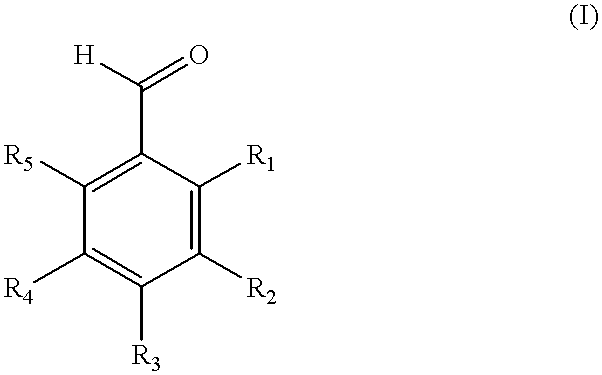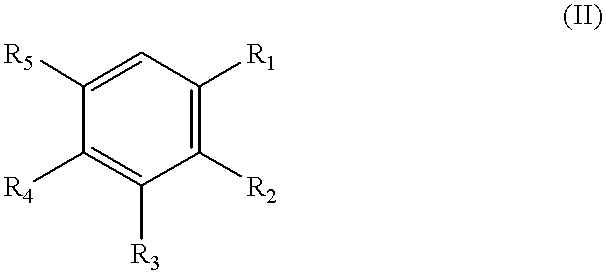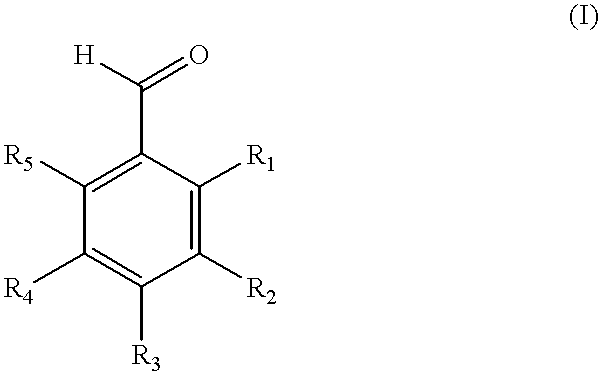Method of producing fluorinated and chlorinated benzaldehydes and compositions thereof
- Summary
- Abstract
- Description
- Claims
- Application Information
AI Technical Summary
Benefits of technology
Problems solved by technology
Method used
Image
Examples
example 1
102.13 g of aluminum chloride (mol. Wt. 133.34; 765.9 mmol) and about 497.04 g of 2-fluorotoluene (mol. Wt. 110.13; 4,513 mmol) were charged to a 2 liter Parry.RTM.-brand 4522 stainless steel reaction vessel. To this mixture was added 5 drops of concentrated HCl. The vessel was sealed, heated to 60.degree. C., and purged three times with carbon monoxide with the pressure of the vessel increased to 200 psi for each purging. After the third purge, the vessel was vented and a final introduction of CO was made at a pressure of about 200 psi, the pressure at which the reaction was maintained for the total reaction time of about 20 hours (the reaction temperature was maintained at 60.degree. C. for the duration as well). Once the reaction was complete, the resultant mixture (exhibiting a dark orange color) was poured into about 500 mL of ice water (which turned the solution a yellow color), to which was added 500 mL of cyclohexane. The top, organic layer was removed and washed three times...
example 2
216.00 g of aluminum chloride (mol. Wt. 133.34; 1,619.9 mmol), 109.09 g (4-Methylanisole (mol. Wt. 122.17; 892.9 mmol), and about 522.35 g of 2-chlorotoluene (mol. Wt. 126.59; 4,126.3 mmol) were charged to a 2 liter Parr.RTM.-brand 4522 stainless steel reaction vessel. To this mixture was added 5 drops of concentrated HCl. The vessel was sealed, heated to 30.degree. C., and purged three times with carbon monoxide with the pressure of the vessel increased to 100 psi for each purging. After the third purge, the vessel was vented and a final introduction of CO was made at a pressure of about 550 psi, the pressure at which the reaction was maintained for the total reaction time of about 66 hours (the reaction temperature was maintained at 30.degree. C. for the duration as well). Once the reaction was complete, the resultant mixture (exhibiting a dark orange color) was poured into about 500 mL of ice water (which turned the solution a yellow color), to which was added 500 mL of cyclohexa...
example 3
229.30 g of aluminum chloride (mol. Wt. 133.34; 1,719.7 mmol), 110.0 g (4-Methylanisole (mol. Wt. 122.17; 900.4 mmol), and about 500 g of 2-fluorotoluene (mol. Wt. 110.13; 4,540.1 mmol) were charged to a 2 liter Parr.RTM.-brand 4522 stainless steel reaction vessel. To this mixture was added 5 drops of concentrated HCl. The vessel was sealed, heated to 30.degree. C., and purged three times with carbon monoxide with the pressure of the vessel increased to 100 psi for each purging. After the third purge, the vessel was vented and a final introduction of CO was made at a pressure of about 550 psi, the pressure at which the reaction was maintained for the total reaction time of about 66 hours (the reaction temperature was maintained at 30.degree. C. for the duration as well). Once the reaction was complete, the resultant mixture (exhibiting a greenish-brown color) was poured into about 500 mL of ice water (which turned the solution a yellow color), to which was added 500 mL of cyclohexan...
PUM
| Property | Measurement | Unit |
|---|---|---|
| Pressure | aaaaa | aaaaa |
| Angle | aaaaa | aaaaa |
| Dimensionless property | aaaaa | aaaaa |
Abstract
Description
Claims
Application Information
 Login to View More
Login to View More - R&D
- Intellectual Property
- Life Sciences
- Materials
- Tech Scout
- Unparalleled Data Quality
- Higher Quality Content
- 60% Fewer Hallucinations
Browse by: Latest US Patents, China's latest patents, Technical Efficacy Thesaurus, Application Domain, Technology Topic, Popular Technical Reports.
© 2025 PatSnap. All rights reserved.Legal|Privacy policy|Modern Slavery Act Transparency Statement|Sitemap|About US| Contact US: help@patsnap.com



